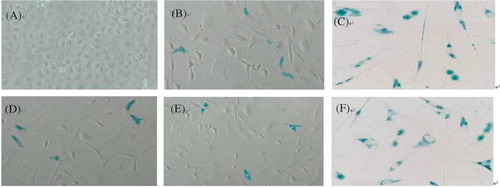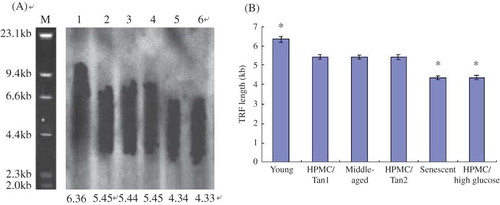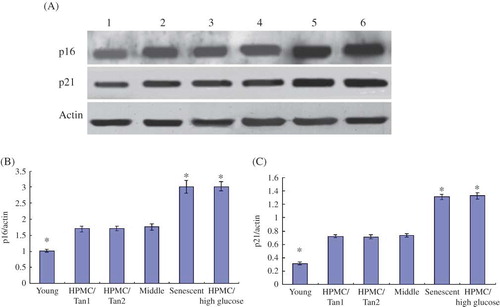Figures & data
Figure 1. Growth curves of young HPMC, HPMC/Tanshinone1, HPMC/Tanshinone2, middle-aged HPMC, senescent HPMC, and HPMC/high glucose by MTT [3-(4,5-dimethylthiazol-2-yl)-2,5-diphenyltetrazolium bromide] assay. The HPMC/high glucose (PD5) showed nearly complete growth inhibition like senescent HPMC (PD10). The growth rate or the growth potential of HPMC/Tanshinone1(PD5) and HPMC/Tanshinone2 (PD5) was similar to that of the middle-aged HPMC (PD5).
![Figure 1. Growth curves of young HPMC, HPMC/Tanshinone1, HPMC/Tanshinone2, middle-aged HPMC, senescent HPMC, and HPMC/high glucose by MTT [3-(4,5-dimethylthiazol-2-yl)-2,5-diphenyltetrazolium bromide] assay. The HPMC/high glucose (PD5) showed nearly complete growth inhibition like senescent HPMC (PD10). The growth rate or the growth potential of HPMC/Tanshinone1(PD5) and HPMC/Tanshinone2 (PD5) was similar to that of the middle-aged HPMC (PD5).](/cms/asset/697e2f45-8e7a-4551-ab36-6db020305aa8/irnf_a_623497_f0001_b.jpg)
Table 1. The rate of cell cycle of HPMC.
Figure 2. Morphology and SA-β-gal senescence-associated marker. Cells were microphotographed at a magnification of 10 × 10. (A) Young HPMC (PD2), (B) middle-aged HPMC (PD5), (C) senescent HPMC (PD10), (D) HPMC/Tanshinone1 (PD5), (E) HPMC/Tanshinone2 (PD5), and (F) HPMC/high glucose (PD5).

Figure 3. (A) The mean terminal restriction fragment (TRF) length of telomere for six groups of HPMC. M: marker; lane 1: young HPMC (PD2); lane 2: HPMC/Tanshinone1 (PD5); lane 3: middle-aged HPMC (PD5); lane 4: HPMC/Tanshinone2 (PD5); lane 5: senescent HPMC (PD10); lane 6: HPMC/high glucose (PD5). (B) The comparisons of the TRF length of telomere in six groups.
Note: *p < 0.05 versus the middle-aged HPMC (PD5).

Figure 4. (A) Western blot showing the expression of p16 and p21 for six groups of HPMC—lane 1: young HPMC (PD2); lane 2: HPMC/Tanshinone1 (PD5); lane 3: HPMC/Tanshinone2 (PD5); lane 4: middle-aged HPMC (PD5); lane 5: senescent HPMC (PD10); lane 6: HPMC/high glucose (PD5). (B) The comparisons of p16/actin in six groups; *p < 0.05 versus the middle-aged HPMC (PD5). (C) The comparisons of p21/actin in six groups; *p < 0.05 versus the middle-aged HPMC (PD5).
